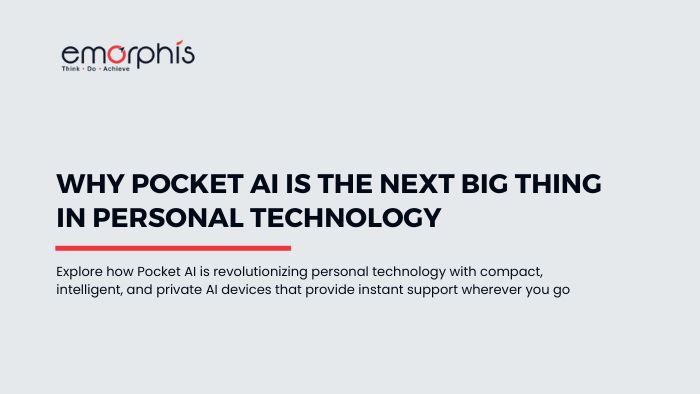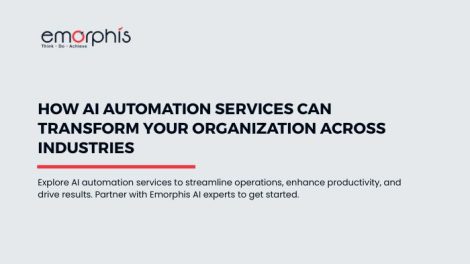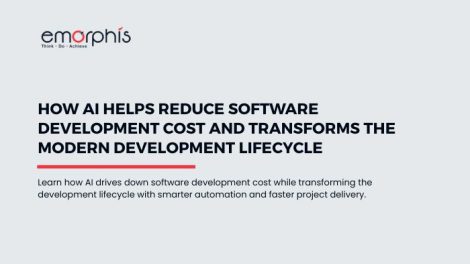What Is the Pocket AI Concept?
It’s not far that in the age of personal technology products, you can live with, learn from, and be helped anywhere you go. A device so small it fits in your pocket, yet so capable it can think, decide, and assist in real time. Let’s name it “Pocket AI,” a concept, as a personal smart assistant, small enough to carry, powerful enough to think.
Pocket AI is a category of artificial intelligence designed for portable use. It includes AI-powered smartphone apps, wearables, and small devices that operate independently or with minimal internet connectivity. Unlike traditional AI systems that require powerful servers or cloud infrastructure, Pocket AI runs on mobile processors or edge computing platforms, enabling real, time decision, making and on-device processing.
This makes Pocket AI ideal for personal use, offering speed, convenience, and privacy without sacrificing intelligence.
Why Pocket AI Matters Now
In a major leap toward the future of personal technology, OpenAI has acquired Jony Ive’s AI hardware startup, io, in a US$ 6.5 billion deal, signaling a bold entry into the world of consumer hardware. This collaboration brings together the technical prowess of OpenAI and the iconic design sensibility of Jony Ive, best known for his groundbreaking work at Apple. Through his design firm LoveFrom, Ive will lead the design of both hardware and software, with around 55 engineers from io joining OpenAI to develop next-generation AI devices. A report by WSJ.
The first of these innovations is expected to launch in 2026 and will take the form of a pocket-sized, screen-free, contextually aware AI device. Unlike wearables or smartphones, this product is not designed to be worn but rather carried, offering a more seamless and natural interaction with artificial intelligence. OpenAI CEO Sam Altman has described it as “a totally new kind of thing,” while Ive called it “the coolest piece of technology that the world will have ever seen.” The device aims to address the drawbacks of traditional smartphones by enabling more intuitive and less intrusive AI experiences.
Let’s check the Pocket AI concept in detail.
This bold move sets the stage for a new era of Pocket AI, a concept that refers to compact, portable AI systems embedded in handheld devices, apps, or wearables.
These tools are not only reshaping how we live and work but are also democratizing access to powerful AI capabilities. From real-time translation and intelligent writing assistance to health tracking and voice-based productivity tools, Pocket AI is making artificial intelligence more accessible, personal, and practical than ever before, no desktop or cloud connection required. As innovation accelerates, Pocket AI is quickly becoming the next big thing in personal technology.
The demand for smart, responsive, and mobile-friendly AI solutions has surged as digital lifestyles become more mobile. People no longer want to sit at a desk to access advanced AI tools. Whether it’s a student looking for quick homework help, a business professional dictating notes, or a traveler needing real-time translation, Pocket AI provides instant solutions in a user’s pocket.
Key Reasons The Pocket AI Concept Is Gaining Momentum
The rise of Pocket AI is more than a passing trend; it’s a response to fundamental shifts in how people use technology in daily life. From increased mobility to growing concerns about data privacy, Pocket AI addresses several modern user needs. Here’s why it’s becoming one of the most sought-after innovations in personal technology:
1. Portability: It Goes Wherever You Go
One of the most attractive features of Pocket AI is its portability. Whether integrated into a smartphone app, wearable device, or compact gadget, Pocket AI is designed to be used on the move. In contrast to traditional AI systems that require a desktop setup or cloud-based infrastructure, Pocket AI is always within arm’s reach, ready to assist whether you’re on a morning commute, traveling internationally, or working remotely.
This physical accessibility makes Pocket AI ideal for users who value flexibility and need solutions in real time, not when they get back to their computer.
Example: A journalist covering a live event can use an AI transcription app like Otter.ai to take real-time notes and quotes, no laptop necessary.
2. Real-Time Assistance: Instant Support for Everyday Tasks
Speed is everything in today’s world. Whether you’re composing an email, translating a menu in a foreign country, or setting up a meeting reminder, Pocket AI delivers intelligent responses within seconds. This kind of real-time support transforms how we manage our time and complete tasks.
Unlike traditional AI tools that require data to be sent to and from cloud servers (causing delays), many Pocket AI solutions operate on-device or with minimal connectivity, enabling near-instant interaction.
Use Cases:
- Writers are using the ChatGPT mobile app to brainstorm blog ideas.
- Travelers using Pocketalk to converse with locals.
- Business users use Notion AI to summarize a meeting on the fly.
- This ability to react immediately makes Pocket AI an essential tool for productivity and problem-solving.
3. Privacy: Offline Functionality That Protects User Data
Data privacy is a growing concern as users become more aware of how their information is collected, stored, and shared. Pocket AI offers a privacy advantage by enabling offline or on-device processing, which significantly reduces the risk of data leaks or breaches.
Edge AI, an underlying technology powering many Pocket AI tools, processes data locally on the device. This eliminates the need to send sensitive information to external servers, enhancing user trust.
Real-World Example: A health-tracking wearable like the Oura Ring can analyze sleep data and biometric information directly on the device, minimizing the need to upload personal data to the cloud.
For users in healthcare, legal, or financial sectors, this privacy-focused feature is not just a convenience; it’s a necessity.
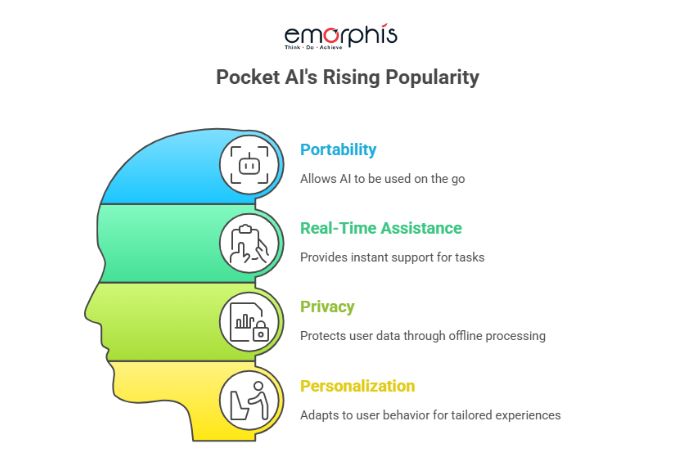
4. Personalization: AI That Learns and Adapts to You
What truly sets Pocket AI apart from generic mobile apps is its ability to learn from individual behavior and preferences. Over time, these tools gather insights from your habits, interactions, and usage patterns to provide hyper-personalized recommendations and support.
For instance:
- A writing assistant can learn your tone and writing style.
- A fitness tracker can adapt workouts based on your performance history.
- A language learning app can adjust difficulty based on how well you’re progressing.
This adaptive capability turns Pocket AI into a digital companion—one that gets smarter and more useful the longer you use it. Personalization also enhances user satisfaction and engagement, ensuring that the experience remains relevant and beneficial over time.
Another term that is trending is, find the details on a beginner’s guide to Agentic AI.
Top Use Cases of Pocket AI
Pocket AI isn’t just a futuristic concept; it’s already making waves across industries and daily routines. With the increasing demand for mobile-first, intelligent solutions, Pocket AI is delivering practical, real-time support in ways that are both innovative and accessible. Here are some of the most impactful use cases of Pocket AI in 2025:
1. Language Translation
Devices like Pocketalk and mobile apps such as Google Translate leverage advanced AI models for real-time, multilingual translation. These tools help travelers, international students, and global professionals break down language barriers instantly, no internet required in many cases.
2. AI Writing Assistants
Apps like ChatGPT, GrammarlyGO, and Jasper empower users to write emails, blogs, reports, and social media posts with precision and speed. Whether you’re on a train or in a café, these Pocket AI tools provide intelligent text suggestions, tone adjustments, and content generation features—all from your mobile device.
3. Voice Transcription and Note-Taking
Pocket AI tools such as Otter.ai, Notta, and Rev Voice Recorder automatically transcribe spoken words into text. These are invaluable for journalists, students, and business professionals who need accurate, on-the-go documentation of meetings, interviews, or lectures.
4. Health Monitoring
Wearables like the Oura Ring, Fitbit Sense, and Apple Watch use embedded AI to analyze biometric data. They can detect anomalies, offer wellness recommendations, and help users maintain healthy lifestyles by providing insights on sleep, heart rate variability, oxygen levels, and stress.
Find details on AI in Patient Care Solution.
5. Mental Health Support
Apps such as Replika, Woebot, and Youper offer emotional support and behavioral coaching through AI-powered conversations. These Pocket AI companions are available 24/7, providing accessible and non-judgmental mental wellness tools for those who may not have access to traditional therapy.
6. Smart Productivity and Organization
Pocket AI tools like Notion AI, Todoist with AI, and Microsoft Copilot help users organize tasks, automate workflows, and manage calendars intelligently. They can suggest priority tasks, auto-schedule meetings, and even summarize documents, all from a smartphone.
7. Personalized Learning and Study Aids
Educational apps like Duolingo Max, Quizlet AI, and Khanmigo (by Khan Academy) provide personalized learning paths using Pocket AI. These tools adapt to the learner’s pace, identify weak areas, and offer interactive tutoring, ideal for students and lifelong learners alike.
8. Visual Search and Real-World Recognition
Apps such as Google Lens, Pinterest Lens, and Vivino use computer vision to analyze and identify objects, landmarks, products, or even wine labels in real time. This use of Pocket AI turns your phone’s camera into a smart scanner that provides instant context and information.
Navigation tools like Google Maps AI, Waze, and Citymapper use AI to provide predictive routing, real-time traffic updates, and personalized travel suggestions. For frequent travelers, AI travel bots like Hopper and Kayak AI assistant also recommend optimal booking times and itineraries.
10. Financial Management and Budgeting
AI-powered finance apps such as Cleo, Monarch Money, and YNAB help users monitor expenses, set savings goals, and receive real-time alerts for unusual spending. These Pocket AI solutions act like a financial advisor in your pocket, especially useful for budgeting on the move.
11. Smart Shopping and Price Tracking
Apps like Fakespot, Honey, and ShopSavvy use Pocket AI to detect fake reviews, compare prices, and recommend the best deals. They enhance the online shopping experience by offering instant insights and price histories with a simple scan or search.
12. On-the-Go Coding and Technical Assistance
Developers are using Pocket AI apps like GitHub Copilot Chat, Codeium, or even the ChatGPT mobile app to debug code, generate scripts, and solve programming problems—anytime, anywhere.

Pocket AI Concept vs Traditional AI Tools
| Feature | Pocket AI Concept | Traditional AI Tools |
| Portability | Ultra-portable; fits in your hand, pocket, or wearable device | Requires a desktop computer, server infrastructure, or cloud |
| Processing | On-device or edge computing; minimal cloud dependency | Primarily cloud-based; dependent on external servers |
| Real-Time Interaction | High responsiveness with minimal latency | Often delayed due to network and server response times |
| User Focus | Designed for individuals; personal, contextual, and adaptive | Geared towards enterprise or large-scale general use |
| Connectivity | Can operate offline or with limited internet | Needs a constant and stable internet connection |
| Data Privacy | Enhanced privacy via local processing | Higher data exposure due to cloud transmission |
| Customization | Learns user behavior to personalize experiences | Limited personalization; generic output for broader use |
| Use Environment | Ideal for mobile, on-the-go scenarios | Best suited for fixed-location environments |
| Maintenance | Low maintenance; updates via app stores or over-the-air | Often requires IT support, manual updates, or backend changes |
| Accessibility | Accessible through smartphones, smartwatches, and small devices | Access typically via desktops, laptops, or enterprise systems |
This contrast illustrates why Pocket AI is gaining popularity among everyday users who prioritize convenience, speed, and data privacy.
Benefits of Pocket AI
The shift toward Pocket AI is not just a trend; it’s a response to real user needs in today’s mobile-first world. Here are the top benefits:
a. Convenience
With Pocket AI, your assistant is always with you; no need to wait until you’re back at your desk.
b. Personalization
These tools adapt over time, learning your habits, preferences, and tone of communication.
c. Offline Capabilities
Edge AI enables processing without internet, making it ideal for travelers or areas with low connectivity.
d. Data Security
By processing information locally, Pocket AI minimizes the risk of data breaches or leaks.
e. Accessibility
Whether it’s a student, freelancer, or entrepreneur, Pocket AI tools are designed for easy use by anyone with a smartphone.

Popular Pocket AI Tools and Devices Right Now
Here are some of the leading examples that define this category:
- ChatGPT Mobile App – Conversational AI for writing, planning, and learning.
- Replika – Emotional support chatbot powered by Pocket AI.
- Notion AI – Smart notes and content generation.
- Otter.ai – Voice transcription and meeting summaries.
- Pocketalk – Real-time language translator.
- Oura Ring – AI-based health analytics in a wearable format.
These tools are just the beginning. With hardware and software improvements, the scope of Pocket AI will only expand.
Future of Pocket AI Concept
Looking ahead, the Pocket AI concept is set to become even more powerful. Expect to see:
- AI-powered smart glasses for real-time information overlays
- AI copilots for wearables and smartphones
- Deeper integration with personal data for hyper-personalized assistance
- Voice, first interactions, removing the need for screens
As tech giants and startups invest in mobile AI, the next generation of personal tech will likely be AI, native, context, aware, and accessible from your pocket.
Thinking of Developing a Pocket AI Product? Here’s How to Get Started
Pocket AI product could be redefining how we engage with technology by delivering intelligent assistance right from our mobile devices. If you’re considering building a Pocket AI product, the timing couldn’t be better. This rapidly growing space offers significant opportunities to innovate and capture market attention.
Here’s what you need to know about developing your own Pocket AI solution.
1. Define the Use Case and Target Audience
Every successful Pocket AI product starts with a clear purpose. Define what problem you’re solving and who will benefit most. Whether it’s a writing assistant for professionals, a health monitor for fitness users, or a multilingual chatbot for travelers, your solution should be tailored to a specific audience with real-world needs.
2. Choose the Right AI Model
Selecting the appropriate AI model is critical. Large language models, speech-to-text engines, and vision models can each serve different functions depending on your use case. Consider whether you’ll need a pre-trained model, a fine-tuned version, or a custom lightweight model optimized for mobile or wearable deployment.
Catch details on AI Consulting services.
3. Plan for On-Device Processing
To deliver a true Pocket AI experience, aim for on-device or edge AI processing. This enables offline functionality, faster responses, and better privacy control. Technologies like TensorFlow Lite, Core ML, and ONNX are useful for deploying AI models on constrained devices without compromising performance.
4. Build a Seamless Mobile or Wearable Interface
A user-friendly interface is essential for adoption. Your Pocket AI app or device should offer intuitive navigation, quick interactions, and voice or gesture-based commands when needed. Prioritize speed, simplicity, and cross-platform usability to enhance user satisfaction.
5. Integrate Personalization and Context Awareness
One of Pocket AI’s strengths lies in personalization. Implement mechanisms to learn from user behavior, location, preferences, and usage patterns. This allows the AI to offer smarter, context-aware interactions that adapt to individual needs over time.
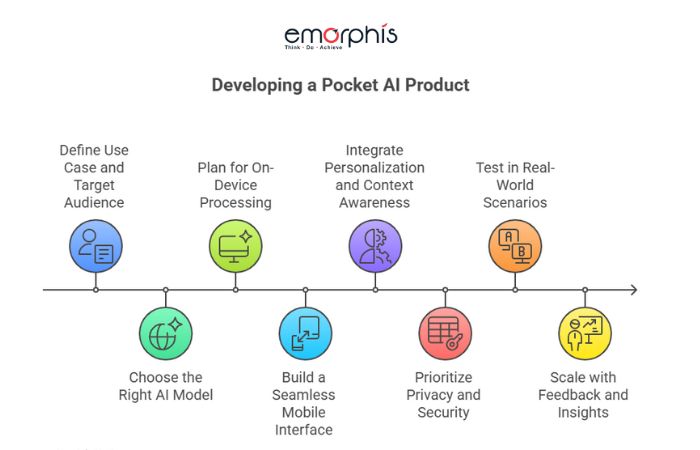
6. Prioritize Privacy and Security
Privacy is non-negotiable in today’s AI landscape. Pocket AI solutions should prioritize local data processing and ensure that all user data is encrypted and stored securely. Transparent privacy policies and compliance with standards like GDPR and HIPAA build user trust and long-term loyalty.
7. Test in Real-World Scenarios
Real-world testing is vital to validate performance and user experience. Test your Pocket AI under different conditions, offline, low connectivity, varied accents, or environments, to ensure reliability. Iterative testing and feedback loops will improve quality before launch.
8. Scale with Feedback and Insights
After deployment, continue refining the product based on user feedback and usage analytics. Update AI models, enhance features, and optimize for battery, speed, and accuracy. A strong feedback mechanism will help scale the product while maintaining high user engagement.
Key Points to Discuss with Your Development Partner
When working with a development team, it’s essential to align on key aspects from the beginning. Discuss the specific use case, AI model selection, edge versus cloud processing strategy, and UI/UX requirements. Also, address data privacy, platform compatibility, scalability plans, and monetization options. Clear communication on these points will ensure a smoother development process and better product-market fit.
Let’s Build Your Pocket AI Product Together
At Emorphis Technologies, we specialize in building intelligent, portable, and user-centric AI solutions. From mobile apps and wearable integrations to fully customized Pocket AI systems, we help innovators bring their ideas to life. If you’re ready to transform your concept into a powerful, market-ready product, connect with us for a consultation. We’re here to guide you through every step of the journey, from ideation to launch and beyond.
Find more details on the AI Software Development Services page.
Conclusion
The age of Pocket AI is here. It combines portability, intelligence, and real-time responsiveness to meet the evolving needs of a mobile, connected world. Whether you’re a student, traveler, business owner, or simply tech-savvy, Pocket AI offers you a personal assistant that fits in your pocket and works around the clock.
As innovation continues, Pocket AI will not only complement our lives but it will also transform how we think, act, and interact with technology.



